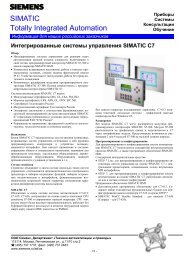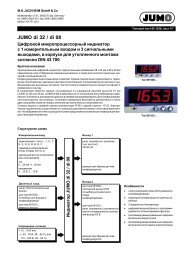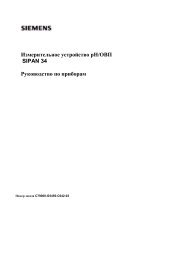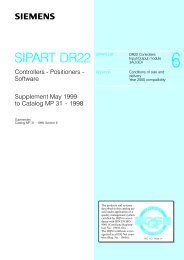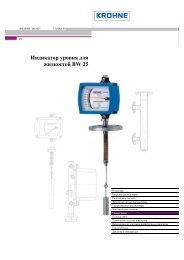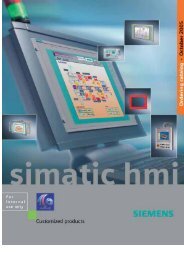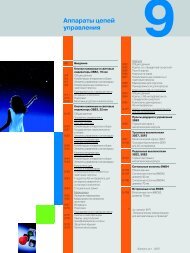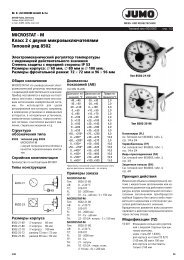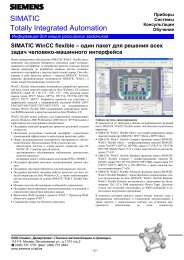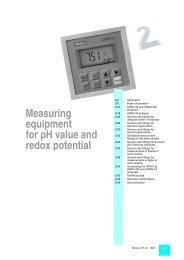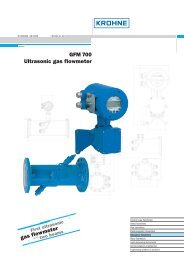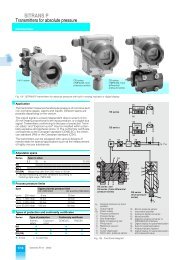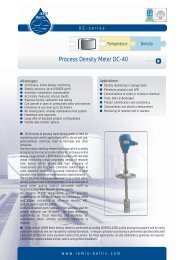SIREC D Display Recorder 7ND4000
SIREC D Display Recorder 7ND4000
SIREC D Display Recorder 7ND4000
Sie wollen auch ein ePaper? Erhöhen Sie die Reichweite Ihrer Titel.
YUMPU macht aus Druck-PDFs automatisch weboptimierte ePaper, die Google liebt.
4 Programming<br />
4.1 INTRODUCTION<br />
This chapter provides information for programming<br />
the <strong>Recorder</strong>. Custom programming is required to<br />
define functions and allows you to personalize features<br />
for performing specific applications and tasks.<br />
The programmed information is stored in nonvolatile<br />
memory until modified by you. Programming is simplified<br />
with menu-driven prompts which minimize the<br />
amount of time required for programming. You have<br />
to program the points or data channels both for<br />
scaling, display and logging or recording. Other<br />
options allow the user to program the display,<br />
alarms and event monitoring as well as overall unit<br />
operation.<br />
NOTE<br />
Programming will be easier with a full understanding<br />
of the programming structure. For<br />
this reason, it is recommended that you read<br />
this entire chapter before attempting to program<br />
your <strong>Recorder</strong>.<br />
NOTE<br />
Refer to Figure 4-1 for the overall <strong>Recorder</strong><br />
programming and menu Flow Chart. Refer to<br />
Chapter 3 of this Manual for the <strong>Display</strong> and<br />
Function menus.<br />
4.1.1 Basic <strong>Recorder</strong> Functions.<br />
The <strong>SIREC</strong> D is a 6 point or 12 point recorder of<br />
which, depending on options, up to 12 channels<br />
may be live or real world inputs. These are typically<br />
voltages or currents. Any channel not being used to<br />
record or display live inputs may be used as a computational<br />
channel. Inputs can be conditioned or<br />
scaled to display any range of engineering units.<br />
Refer to Figure 4-2.<br />
Siemens AG C79000-G7374-C211-01<br />
<strong>SIREC</strong> D Manual<br />
Programming<br />
A. Levels of Data Handling - There are four<br />
distinct levels of data handling, namely conversion,<br />
conditioning, scaling and display/record.<br />
1. Conversion - Conversion applies only to live<br />
inputs and is the process of converting real world<br />
analog signals into a 16-bit digital value that can<br />
be used by the <strong>Recorder</strong>. There are three fullscale<br />
ranges for all conversions, 100 milliVolts, 1<br />
Volt or 10 Volts DC, full scale. The converted values<br />
pass to a conditioning block which converts<br />
the binary value, which is effectively a percentage<br />
of full scale, into a value useful to the user.<br />
2. Conditioning - Conditioning includes converting<br />
the binary value into a representative voltage,<br />
conditioning and linearizing this voltage to represent<br />
for example, a real world temperature as<br />
might be input by a thermocouple or RTD, and<br />
applying any other computation as required. The<br />
conditioning block handles 12 channels. The outputs<br />
from the conditioning block are referred to as<br />
base points and may be fed back to the inputs of<br />
the conditioning block to form the basis (base<br />
point) for other base point computations. This includes<br />
tracking peak or valley values, doing moving<br />
averages, timed averages, difference, totalization<br />
or any other user-entered equation.<br />
The input to any channel in the conditioning block<br />
can be any one of the base points, or in the case<br />
of channels 1 through 6, can be the live inputs.<br />
Live inputs can have input and output scaling applied<br />
in the conditioning block unless this is predefined<br />
by the nature of the input, i.e., thermocouples.<br />
3. Scaling - The outputs of the conditioning block<br />
are also the values represented in the Digital<br />
Windows and are real-world engineering values.<br />
The outputs of the conditioning block are also fed<br />
through to a scale block where a chart scale is<br />
applied to each point. The chart scales determine<br />
what part of the full scale range will be used by<br />
the display/record block. There are two sets of 8<br />
scales available to the user. The second set is an<br />
alternate set which can be applied to the base<br />
points in place of the normal set when triggered<br />
by an external event. Each chart scale may be<br />
applied to any one or more of the base points to<br />
provide an output scaled point.<br />
4-1




